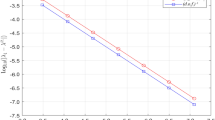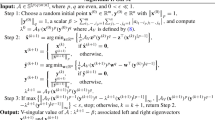Abstract
Modified incomplete LU/Cholesky factorizations without fill-ins are popular preconditioners for Krylov subspace methods, because they require no extra memory and have more potential of accelerating the convergence than simple ILU/IC preconditioners. For parallelizing preconditioners, the block red–black ordering is attractive due to its highly parallel nature and small number of synchronization points. Hence, their combination seems to produce powerful and parallelizable preconditioners. In fact, however, this combination can cause breakdown of the factorization due to the occurrence of zero pivots. We analyze this phenomenon and give necessary and sufficient conditions of zero pivots in the case of a regular grid. We also show both theoretically and experimentally that adding perturbation to the diagonal elements or relaxing the compensation of dropped fill-ins is useful to alleviate the problem. Numerical tests show that the resulting preconditioners are highly effective and are applicable for up to \(10^3\) level of parallelism.







Similar content being viewed by others
Notes
Strictly speaking, a breakdown can occur in the elimination of a row \(i^{\prime }<i\) not belonging to \(\mathcal {I}(i)\). But this can be avoided by changing the order of elimination so that the rows in \(\mathcal {I}(i)\cup \{i\}\) are eliminated first.
References
Birdsall, C.K.: Particle-in-cell charged-particle simulations, plus Monte Carlo collisions with neutral atoms, PIC-MCC. IEEE Trans. Plasma Sci. 19(2), 65–85 (1991)
Hirsch, C.: Numerical Computation of Internal and External Flows: The Fundamentals of Computational Fluid Dynamics. Butterworth-Heinemann, Oxford (2007)
Meijerink, J.A., van der Vorst, H.A.: An iterative solution method for linear systems of which the coefficient matrix is a symmetric \(M\)-matrix. Math. Comput. 31, 148–162 (1977)
Gustafsson, I.: A class of first order factorization methods. BIT 18, 142–156 (1978)
Greenbaum, A.: Iterative Methods for Solving Linear Systems. SIAM, Philadelphia (1997)
Fujino, S., Mori, M., Takeuchi, T.: Performance of hyperplane ordering on vector computers. J. Comput. Appl. Math. 38, 125–136 (1991)
George, A., Liu, J.W.H.: Computer Solution of Large Sparse Positive Definite Systems. Prentice-Hall, Englewood Cliffs (1981)
Davis, T.A.: Direct Methods for Sparse Linear Systems. SIAM, Philadelphia (2006)
Saad, Y.: Iterative Methods for Sparse Linear Systems, 2nd edn. SIAM, Philadelphia (2003)
Iwashita, T., Shimasaki, M.: Block red-black ordering for parallelized ICCG solver with fewer synchronization points. IPSJ J. 43, 893–904 (2002–2004)
Iwashita, T., Shimasaki, M.: Algebraic block red-black ordering method for parallelized ICCG solver with fast convergence and low communication costs. IEEE Trans. Magn. 39, 1713–1716 (2003)
Semba, K., Tani, K., Yamada, T., Iwashita, T., Takahashi, Y., Nakashima, H.: Parallel performance of multi-threaded ICCG solver based on algebraic block multi-color ordering in finite element electromagnetic field analyses. IEEE Trans. Magn. 49, 1581–1584 (2013)
Iwashita, T., Nakashima, H., Takahashi, Y.: Algebraic block multi-color ordering method for parallel multi-threaded sparse triangular solver in ICCG method. In: 2012 IEEE 26th International Parallel and Distributed Processing Symposium (IPDPS), pp. 474–483. IEEE (2012)
Guessous, N., Souhar, O.: The effect of block red-black ordering on block ILU preconditioner for sparse matrices. J. Appl. Math. Comput. 17, 283–296 (2005)
Eijkhout, V.: Beware of unperturbed modified incomplete factorizations. In: Belgium, B., Beauwens, R., de Groen, P. (eds.) Proc. of the IMACS International Symposium on Iterative Methods in Linear Algebra (1992)
Gustafsson, I.: Modified incomplete Cholesky (MIC) methods. In: Evans, D. (ed.) Preconditioning Methods Theory and Applications, pp. 265–293. Gordon and Breach, New York (1983)
Axelsson, O., Lindskog, G.: On the eigenvalue distribution of a class of preconditioning method. Numer. Math. 48, 479–498 (1986)
Eijkhout, V.: Analysis of parallel incomplete point factorizations. Linear Algebra Appl. 154, 723–740 (1991)
Van der Vorst, H.A.: BI-CGSTAB: a fast and smoothly converging variant of BI-CG for the solution of nonsymmetric linear systems. SIAM J. Sci. Stat. Comput. 13(2), 631–644 (1992)
Acknowledgements
We are grateful to the anonymous reviewer, whose comments helped us to improve the quality of this paper. We thank Prof. Takeshi Iwashita of Hokkaido University for valuable comments on our work. The present study is supported in part by the Ministry of Education, Science, Sports and Culture, Grant-in-Aid for Scientific Research (nos. 26286087, 15H02708, 15H02709, 16KT0016, 17H02828, 17K19966). The computational experiments in this paper were performed using the FX10 parallel computer at the Education Center on Computational Science and Engineering of Kobe University.
Author information
Authors and Affiliations
Corresponding author
Appendix: Proof of Theorem 4
Appendix: Proof of Theorem 4
Proof
As we showed in the proof of Theorem 3, the off-diagonal nonzero elements of A are unchanged throughout the factorization and remain negative. Note also that if \(k\in \mathcal {I}(i)\cup \{i\}\), \(\sum _{l\ne k}(-a_{kl})=a_{kk}=1\) from the zero row sum property. Hence, \(0<\xi \le \eta \le 1\).
Before going into the proof, we introduce some notations. Let \(\mathcal {L}(k)\) and \(\mathcal {R}(k)\) be the set of column indices of nonzero elements to the left and right of the diagonal, respectively, in the k-th row. Then, \(\mathcal {L}(k)\) is the set of indices of the rows that update the k-th row. Also, since A has a symmetric nonzero pattern, \(\mathcal {R}(k)\) is the set of indices of the rows updated by the k-th row. We also denote by \(r_k\) the row sum of the k-th row after elimination. Since there are no nonzero elements to the left of the diagonal after elimination, we have
If \(k\in \mathcal {I}(i)\cup \{i\}\), we have
from the zero row sum property. Combining (9) with (10) gives
Now, suppose that \(k\in \mathcal {I}(i)\cup \{i\}\) and \(\mathcal {L}(k)\ne \emptyset \). We consider the change of the row sum of row k due to elimination by row \(l\in \mathcal {L}(k)\). By this elimination, \(a_{kl}\) is annihilated and other off-diagonal elements remain intact. Hence, the contribution to the row sum from the off-diagonal elements increases by \(-a_{kl}\). The diagonal element \(a_{kk}\) increases by \(-a_{kl}a_{lk}/u_{ll}\) by the elimination. The sum of fill-ins to be added to the diagonal is \(-\alpha (a_{kl}/u_{ll})\sum _{j\in \mathcal {R}(l)\backslash \{k\}}a_{lj}\). Combining all of these contributions, we can write the change in the row sum as
where we used (9) in the last equality. We define \(s_{lk}\) by
Then, since the initial row sum of row k is zero, the final row sum that takes into account the contributions from all \(l\in \mathcal {L}(k)\) can be written as
Equations (11), (13) and (14) describe the propagation of the change in the row sums during the process of relaxed modified incomplete factorization.
To prove the theorem, we show that for any \(k\in \mathcal {I}(i)\) and \(m\in \mathcal {R}(k)\),
We proceed by induction. First consider the case of \(\mathcal {D}(k)=0\). In this case, row k is not altered by any row since \(\mathcal {I}(k)=\emptyset \). Hence, \(u_{kk}=a_{kk}=1\) and \(r_k=0\) from the condition (ii) of Theorem 1. Also, since row k is not altered by any row, it has no nonzero elements to the left of the diagonal and all of its p off-diagonal nonzero elements lie to the right of the diagonal. Thus, from Eq. (13), \(s_{km}\) can be bounded from below as
and the claim holds. Next, assume that Eq. (15) holds for all rows in \(\mathcal {I}(i)\) with depth smaller than d, where d is some positive integer. Now, pick up a row \(k\in \mathcal {I}(i)\) with \(\mathcal {D}(k)=d\). Then, the row l used in the elimination of row k satisfies \(\mathcal {D}(l)<d\) and hence \(s_{lk} \ge (1-\alpha )(p-1)\xi \) from the hypothesis. Thus, the row sum of row k after elimination can be evaluated as
On the other hand, putting (11) into the definition of \(s_{km}\), Eq. (13), yields
We bound the right-hand side from below. Let \(\mathcal {L}(k)=q\) and \(\mathcal {R} (k)=p-q\). Since row k is updated by at least one row, \(q\ge 1\). Also, \(q\le p-1\), since otherwise \(\mathcal {R} (k)=\emptyset \), which contradicts the assumption that \(k\in \mathcal {I}(i)\). We note that the first term in the numerator of (18) can be bounded by the sum of the first and the second terms in the denominator as
where we used the zero row sum property in the last equality. Then, by applying the general inequality \(\frac{b+\epsilon }{a+\epsilon }\ge \frac{b+\delta }{a+\delta }\) that holds for four positive numbers \(a, b, \epsilon \) and \(\delta \) with \(a\ge b\) and \(\epsilon \ge \delta \) to Eq. (18) (with \(\epsilon =r_k\) and \(\delta \) being the right-hand side of (17)), we have
The numerator can be rewritten as
where we used the zero row sum property in the first equality. The denominator can be bounded as
where we used \((p-1)\xi \le 1\) and \(\sum _{l\in \mathcal {L}(k)}(-a_{kl})\le 1\). Inserting (21) and (22) into (20) gives
Noting that the denominator of the right-hand side is positive, we know that the claim (15) holds if
or
The right-hand side is a linear function of q and and its minimum in the interval \(1\le q\le p-1\) is
In either case, the minimum is larger than or equal to \(\eta \) from the condition (7) and thus (15) holds also for k. Hence, the induction is complete and (15) holds for any \(k\in \mathcal {I}(i)\) and \(m\in \mathcal {R}(k)\).
Now that (15) has been established, we bound the pivots \(u_{kk}\) for \(k\in \mathcal {I}(i)\cup \{i\}\) from below. If \(\mathcal {D}(k)=0\), row k is not eliminated by any row, so, from the scaling assumption, \(u_{kk}=1> (1-\alpha )(p-1)\xi ^2\). Next, assume that \(k\in \mathcal {I}(i)\) and \(\mathcal {D}(k)>0\). Then, there is at least one nonzero element to the left of the diagonal. Thus, from (14) and (15), it follows that
Combining this with (9), we have
Finally, consider the case of \(k=i\). In this case, there is no nonzero element to the right of the diagonal and therefore \(\sum _{l\in \mathcal {L}(i)}(-a_{il})=a_{ii}=1\). Hence,
and we have from (9),
This completes the proof. \(\square \)
About this article
Cite this article
Shioya, A., Yamamoto, Y. The danger of combining block red–black ordering with modified incomplete factorizations and its remedy by perturbation or relaxation. Japan J. Indust. Appl. Math. 35, 195–216 (2018). https://doi.org/10.1007/s13160-017-0277-5
Received:
Revised:
Published:
Issue Date:
DOI: https://doi.org/10.1007/s13160-017-0277-5




